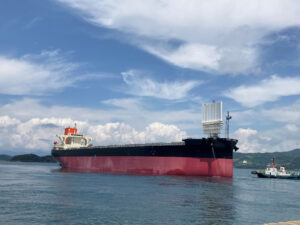
Wind-powered cargo capacity surpasses one million DWT

The latest installations of wind propulsion technology on large commercial vessels have tipped the amount of cargo that can be transported on vessels that make use of wind as a renewable energy source over the one million tonnes of deadweight (DWT) milestone.
In recent years, there has been a resurgence of interest in equipping vessels to harness the power of the wind. What was once romanticised as a historic way to sail cargo across the world’s oceans has become a credible option for modern vessels, fuelled by incoming carbon reduction targets and high fuel prices.
According to the International Windship Association (IWSA) twenty-one large commercial vessels currently have wind propulsion systems installed onboard representing over one million DWT of cargo carrying capacity. By the end of this year, IWSA estimates that wind propulsion technology will be installed on around twenty-five large commercial vessels, representing 1.2 million DWT.
Based on public announcements and shipyard orders made to-date, IWSA also estimates that by the end of 2023, up to fifty large ships will be making use of wind as a renewable energy source with a combined tonnage of over three million DWT.
In addition to the fleet of large commercial ships sailing with wind propulsion technology installed, ten small cruise ships currently use traditional soft sail technology representing a further 50,000 Gross Register Tonnage (GRT).
There is also a growing number of smaller vessels (under 400 GRT) using wind propulsion technology. The number of smaller vessels will also likely grow in the next year as more vessels are converted to sail cargo, retrofits on small fishing vessels are undertaken, and a demonstrator vessel is launched in the South Pacific.
“Wind propulsion technologies are proven to save 5-20% in fuel use and associated emissions when used as wind-assist on motor vessel profiles,” says Gavin Allwright, IWSA secretary general. “The savings potential is even higher for vessels that use primary wind technologies to achieve much higher levels of propulsive energy sourced from wind. This makes wind power a valuable pathway to reducing the emissions of the international shipping industry immediately and over the longer-term. It also offers the potential for enabling a substantial reduction in the carbon intensity of the whole fleet.
“With 50 wind propulsion system rigs installed to-date on those 21 ships, and an anticipated 100 rigs installed milestone to be passed by the end of 2023, the price of propulsion technology is coming down. Reaching the one-hundred rigs installed milestone will represent an important market marker for wind propulsion technology in particular. At this point we can expect a sustained reduction in return-on-investment timeframes, especially if fuel prices remain high. It’s easy to see why wind is becoming an increasingly attractive option for ship owners given its positive financial and decarbonisation potential and the fact that this technology basket delivers on compliance issues, today.”
Earlier this year, MIN reported that a development project for the construction of a 136m, wind-powered merchant ship is underway by Nantes-based eco-responsible and low-carbon shipping company Neoline. Construction of its first Neoliner cargo ship will begin this year, ready for it to enter service in 2024-25. Also, Norsepower successfully installed two 35m tall rotor sails for Sea-Cargo, a logistics provider in the North Sea market in January 2021. This installation is said to be the world’s first tiltable rotor sail, showcasing that vessels that have to negotiate height restricted routes can benefit from this fuel and emissions-saving solution and in June 2021, French multinational Michelin has announced its Wing Sail Mobility project.
IWSA is a member driven, not-for-profit association made up of wind propulsion technology suppliers and ship development projects, shipping lines, shipbuilders, designers, naval architects, engineers, academics, NGO’s, and Class with five main areas of activity.
